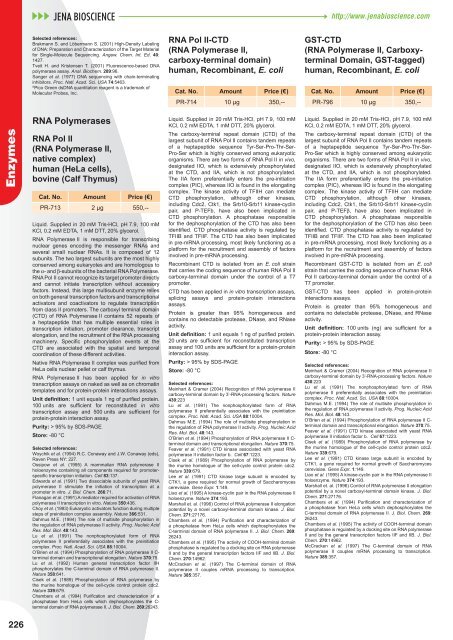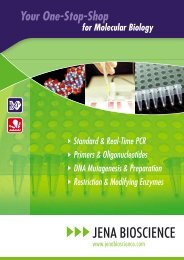Nucleotide Analogs - Jena Bioscience
Nucleotide Analogs - Jena Bioscience
Nucleotide Analogs - Jena Bioscience
Create successful ePaper yourself
Turn your PDF publications into a flip-book with our unique Google optimized e-Paper software.
Enzymes<br />
226<br />
Selected references:<br />
Brakmann S. and Löbermann S. (2001) High-Density Labeling<br />
of DNA: Preparation and Characterization of the Target Material<br />
for Single-Molecule Sequencing. Angew. Chem. Int. Ed. 40:<br />
1427.<br />
Tveit H. and Kristensen T. (2001) Fluorescence-based DNA<br />
polymerase assay. Anal. Biochem. 289:96.<br />
Sanger et al. (1977) DNA sequencing with chain-terminating<br />
inhibitors. Proc. Natl. Acad. Sci. USA 74:5463.<br />
® Pico Green dsDNA quantitation reagent is a trademark of<br />
Molecular Probes, Inc.<br />
RNA Polymerases<br />
RNA Pol II<br />
(RNA Polymerase II,<br />
native complex)<br />
human (HeLa cells),<br />
bovine (Calf Thymus)<br />
Cat. No. Amount Price (€)<br />
PR-713 2 µg 550,--<br />
Liquid. Supplied in 20 mM Tris-HCl, pH 7.9, 100 mM<br />
KCl, 0.2 mM EDTA, 1 mM DTT, 20% glycerol.<br />
RNA Polymerase II is responsible for transcribing<br />
nuclear genes encoding the messenger RNAs and<br />
several small nuclear RNAs. It is composed of 12<br />
subunits. The two largest subunits are the most highly<br />
conserved among eukaryotes and are homologous to<br />
the α- and β-subunits of the bacterial RNA Polymerase.<br />
RNA Pol II cannot recognize its target promoter directly<br />
and cannot initiate transcription without accessory<br />
factors. Instead, this large multisubunit enzyme relies<br />
on both general transcription factors and transcriptional<br />
activators and coactivators to regulate transcription<br />
from class II promoters. The carboxyl terminal domain<br />
(CTD) of RNA Polymerase II contains 52 repeats of<br />
a heptapeptide that has multiple essential roles in<br />
transcription initiation, promoter clearance, transcript<br />
elongation, and the recruitment of the RNA processing<br />
machinery. Specifi c phosphorylation events at the<br />
CTD are associated with the spatial and temporal<br />
coordination of these different activities.<br />
Native RNA Polymerase II complex was purifi ed from<br />
HeLa cells nuclear pellet or calf thymus.<br />
RNA Polymerase II has been applied for in vitro<br />
transcription assays on naked as well as on chromatin<br />
templates and for protein-protein interactions assays.<br />
Unit defi nition: 1 unit equals 1 ng of purifi ed protein.<br />
100 units are suffi cient for reconstituted in vitro<br />
transcription assay and 500 units are suffi cient for<br />
protein-protein interaction assay.<br />
Purity: > 95% by SDS-PAGE.<br />
Store: -80 °C<br />
Selected references:<br />
Woychik et al. (1994) R.C. Conaway and J.W. Conaway (eds),<br />
Raven Press NY: 227.<br />
Ossipow et al. (1995) A mammalian RNA polymerase II<br />
holoenzyme containing all components required for promoterspecifi<br />
c transcription initiation. Cell 83:137.<br />
Edwards et al. (1991) Two dissociable subunits of yeast RNA<br />
polymerase II stimulate the initiation of transcription at a<br />
promoter in vitro. J. Biol. Chem. 266:71.<br />
Flanagan et al. (1991) A mediator required for activation of RNA<br />
polymerase II transcription in vitro. Nature 350:436.<br />
Choy et al. (1993) Eukaryotic activators function during multiple<br />
steps of preinitiation complex assembly. Nature 366:531.<br />
Dahmus M.E. (1994) The role of multisite phosphorylation in<br />
the regulation of RNA polymerase II activity. Prog. Nucleic Acid<br />
Res. Mol. Biol. 48:143.<br />
Lu et al. (1991) The nonphosphorylated form of RNA<br />
polymerase II preferentially associates with the preinitiation<br />
complex. Proc. Natl. Acad. Sci. USA 88:10004.<br />
O’Brien et al. (1994) Phosphorylation of RNA polymerase II Cterminal<br />
domain and transcriptional elongation. Nature 370:75.<br />
Lu et al. (1992) Human general transcription factor IIH<br />
phosphorylates the C-terminal domain of RNA polymerase II.<br />
Nature 358:641.<br />
Cisek et al. (1989) Phosphorylation of RNA polymerase by<br />
the murine homologue of the cell-cycle control protein cdc2.<br />
Nature 339:679.<br />
Chambers et al. (1994) Purifi cation and characterization of a<br />
phosphatase from HeLa cells which dephosphorylates the Cterminal<br />
domain of RNA polymerase II. J. Biol. Chem. 269:26243.<br />
RNA Pol II-CTD<br />
(RNA Polymerase II,<br />
carboxy-terminal domain)<br />
human, Recombinant, E. coli<br />
Cat. No. Amount Price (€)<br />
PR-714 10 µg 350,--<br />
Liquid. Supplied in 20 mM Tris-HCl, pH 7.9, 100 mM<br />
KCl, 0.2 mM EDTA, 1 mM DTT, 20% glycerol.<br />
The carboxy-terminal repeat domain (CTD) of the<br />
largest subunit of RNA Pol II contains tandem repeats<br />
of a heptapeptide sequence Tyr-Ser-Pro-Thr-Ser-<br />
Pro-Ser which is highly conserved among eukaryotic<br />
organisms. There are two forms of RNA Pol II in vivo,<br />
designated IIO, which is extensively phosphorylated<br />
at the CTD, and IIA, which is not phosphorylated.<br />
The IIA form preferentially enters the pre-initiation<br />
complex (PIC), whereas IIO is found in the elongating<br />
complex. The kinase activity of TFIIH can mediate<br />
CTD phosphorylation, although other kinases,<br />
including Cdc2, Ctk1, the Srb10-Srb11 kinase-cyclin<br />
pair, and P-TEFb, have also been implicated in<br />
CTD phosphorylation. A phosphatase responsible<br />
for the dephosphorylation of the CTD has also been<br />
identifi ed. CTD phosphatase activity is regulated by<br />
TFIIB and TFIIF. The CTD has also been implicated<br />
in pre-mRNA processing, most likely functioning as a<br />
platform for the recruitment and assembly of factors<br />
involved in pre-mRNA processing.<br />
Recombinant CTD is isolated from an E. coli strain<br />
that carries the coding sequence of human RNA Pol II<br />
carboxy-terminal domain under the control of a T7<br />
promoter.<br />
CTD has been applied in in vitro transcription assays,<br />
splicing assays and protein-protein interactions<br />
assays.<br />
Protein is greater than 95% homogeneous and<br />
contains no detectable protease, DNase, and RNase<br />
activity.<br />
Unit defi nition: 1 unit equals 1 ng of purifi ed protein.<br />
20 units are suffi cient for reconstituted transcription<br />
assay and 100 units are suffi cient for a protein-protein<br />
interaction assay.<br />
Purity: > 95% by SDS-PAGE.<br />
Store: -80 °C<br />
Selected references:<br />
Meinhart & Cramer (2004) Recognition of RNA polymerase II<br />
carboxy-terminal domain by 3’-RNA-processing factors. Nature<br />
430:223<br />
Lu et al. (1991) The nonphosphorylated form of RNA<br />
polymerase II preferentially associates with the preinitiation<br />
complex. Proc. Natl. Acad. Sci. USA 88:10004.<br />
Dahmus M.E. (1994) The role of multisite phosphorylation in<br />
the regulation of RNA polymerase II activity. Prog. Nucleic Acid<br />
Res. Mol. Biol. 48:143.<br />
O’Brien et al. (1994) Phosphorylation of RNA polymerase II Cterminal<br />
domain and transcriptional elongation. Nature 370:75.<br />
Feaver et al. (1991) CTD kinase associated with yeast RNA<br />
polymerase II initiation factor b. Cell 67:1223.<br />
Cisek et al. (1989) Phosphorylation of RNA polymerase by<br />
the murine homologue of the cell-cycle control protein cdc2.<br />
Nature 339:679.<br />
Lee et al. (1991) CTD kinase large subunit is encoded by<br />
CTK1, a gene required for normal growth of Saccharomyces<br />
cerevisiae. Gene Expr. 1:149.<br />
Liao et al. (1995) A kinase-cyclin pair in the RNA polymerase II<br />
holoenzyme. Nature 374:193.<br />
Marshall et. al. (1996) Control of RNA polymerase II elongation<br />
potential by a novel carboxyl-terminal domain kinase. J. Biol.<br />
Chem. 271:27176.<br />
Chambers et al. (1994) Purifi cation and characterization of<br />
a phosphatase from HeLa cells which dephosphorylates the<br />
C-terminal domain of RNA polymerase II. J. Biol. Chem. 269:<br />
26243.<br />
Chambers et al. (1995) The activity of COOH-terminal domain<br />
phosphatase is regulated by a docking site on RNA polymerase<br />
II and by the general transcription factors IIF and IIB. J. Biol.<br />
Chem. 270:14962.<br />
McCracken et al. (1997) The C-terminal domain of RNA<br />
polymerase II couples mRNA processing to transcription.<br />
Nature 385:357.<br />
http://www.jenabioscience.com<br />
GST-CTD<br />
(RNA Polymerase II, Carboxyterminal<br />
Domain, GST-tagged)<br />
human, Recombinant, E. coli<br />
Cat. No. Amount Price (€)<br />
PR-796 10 µg 350,--<br />
Liquid. Supplied in 20 mM Tris-HCl, pH 7.9, 100 mM<br />
KCl, 0.2 mM EDTA, 1 mM DTT, 20% glycerol.<br />
The carboxy-terminal repeat domain (CTD) of the<br />
largest subunit of RNA Pol II contains tandem repeats<br />
of a heptapeptide sequence Tyr-Ser-Pro-Thr-Ser-<br />
Pro-Ser which is highly conserved among eukaryotic<br />
organisms. There are two forms of RNA Pol II in vivo,<br />
designated IIO, which is extensively phosphorylated<br />
at the CTD, and IIA, which is not phosphorylated.<br />
The IIA form preferentially enters the pre-initiation<br />
complex (PIC), whereas IIO is found in the elongating<br />
complex. The kinase activity of TFIIH can mediate<br />
CTD phosphorylation, although other kinases,<br />
including Cdc2, Ctk1, the Srb10-Srb11 kinase-cyclin<br />
pair, and P-TEFβ, have also been implicated in<br />
CTD phosphorylation. A phosphatase responsible<br />
for the dephosphorylation of the CTD has also been<br />
identifi ed. CTD phosphatase activity is regulated by<br />
TFIIB and TFIIF. The CTD has also been implicated<br />
in pre-mRNA processing, most likely functioning as a<br />
platform for the recruitment and assembly of factors<br />
involved in pre-mRNA processing.<br />
Recombinant GST-CTD is isolated from an E. coli<br />
strain that carries the coding sequence of human RNA<br />
Pol II carboxy-terminal domain under the control of a<br />
T7 promoter.<br />
GST-CTD has been applied in protein-protein<br />
interactions assays.<br />
Protein is greater than 95% homogeneous and<br />
contains no detectable protease, DNase, and RNase<br />
activity.<br />
Unit defi nition: 100 units (ng) are suffi cient for a<br />
protein-protein interaction assay.<br />
Purity: > 95% by SDS-PAGE.<br />
Store: -80 °C<br />
Selected references:<br />
Meinhart & Cramer (2004) Recognition of RNA polymerase II<br />
carboxy-terminal domain by 3’-RNA-processing factors. Nature<br />
430:223<br />
Lu et al. (1991) The nonphosphorylated form of RNA<br />
polymerase II preferentially associates with the preinitiation<br />
complex. Proc. Natl. Acad. Sci. USA 88:10004.<br />
Dahmus M.E. (1994) The role of multisite phosphorylation in<br />
the regulation of RNA polymerase II activity. Prog. Nucleic Acid<br />
Res. Mol. Biol. 48:143.<br />
O’Brien et al. (1994) Phosphorylation of RNA polymerase II Cterminal<br />
domain and transcriptional elongation. Nature 370:75.<br />
Feaver et al. (1991) CTD kinase associated with yeast RNA<br />
polymerase II initiation factor b. Cell 67:1223.<br />
Cisek et al. (1989) Phosphorylation of RNA polymerase by<br />
the murine homologue of the cell-cycle control protein cdc2.<br />
Nature 339:679.<br />
Lee et al. (1991) CTD kinase large subunit is encoded by<br />
CTK1, a gene required for normal growth of Saccharomyces<br />
cerevisiae. Gene Expr. 1:149.<br />
Liao et al. (1995) A kinase-cyclin pair in the RNA polymerase II<br />
holoenzyme. Nature 374:193.<br />
Marshall et. al. (1996) Control of RNA polymerase II elongation<br />
potential by a novel carboxyl-terminal domain kinase. J. Biol.<br />
Chem. 271:27176.<br />
Chambers et al. (1994) Purifi cation and characterization of<br />
a phosphatase from HeLa cells which dephosphorylates the<br />
C-terminal domain of RNA polymerase II. J. Biol. Chem. 269:<br />
26243.<br />
Chambers et al. (1995) The activity of COOH-terminal domain<br />
phosphatase is regulated by a docking site on RNA polymerase<br />
II and by the general transcription factors IIF and IIB. J. Biol.<br />
Chem. 270:14962.<br />
McCracken et al. (1997) The C-terminal domain of RNA<br />
polymerase II couples mRNA processing to transcription.<br />
Nature 385:357.



